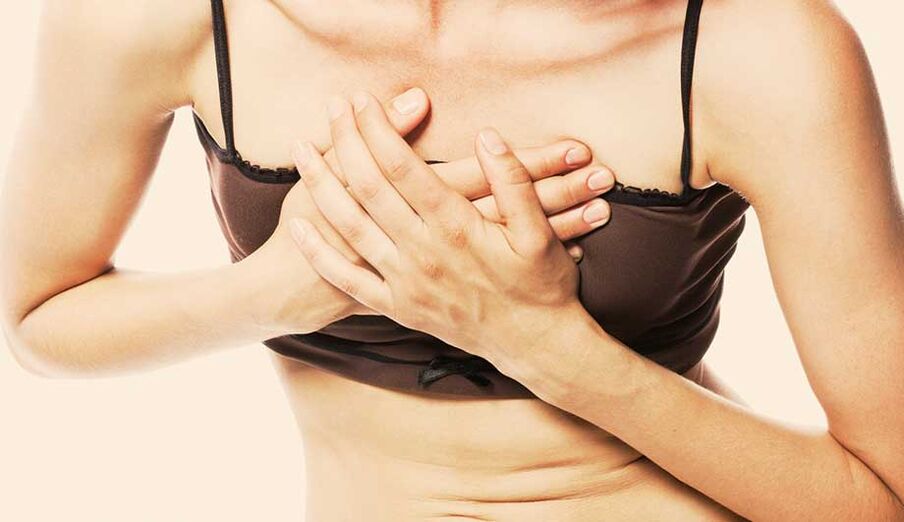Osteochondrosis is a very dangerous disease. It occurs unnoticed, and mild discomfort develops into severe spinal disorders that sometimes result in disability.

Therapists, neurologists, orthopedists, vertebrologists and other professionals are involved in the treatment of this disease.
Symptoms and feelings of chest osteochondrosis
Osteochondrosis of the thoracic spine occurs less frequently than osteochondrosis of the cervical or lumbar spine. The thoracic vertebrae are less agile and better protected. This disease is complicated by the fact that the symptoms are difficult to recognize and can later lead to many other diseases.
One of the main reasons for the appearance of osteochondrosis in the thoracic region is the presence of scoliosis in humans. As the curvature of the spine increases, the pressure on the vertebrae increases and their displacement occurs, and the plates from the spinal column are lost. The pain in this disease is indicated by changes in the vertebrae, interruption of metabolism and blood supply. This disease mostly affects people living sedentary lifestyles, office workers, drivers, students.
In chest osteochondrosis, the symptoms and feelings are divided into the main pain syndromes: dorsago and dorsalgia. Dorsalgia is a prolonged chronic pain that causes mild and little discomfort to the patient. Dorsago sudden, sharp pain. It occurs when a person is in a certain situation for a long time and changes it dramatically. Shortness of breath may occur, become heavy, and muscles may be poorly controlled.
Chest degenerative disc disease: symptoms and feelings are typical and atypical
Osteochondrosis of the thoracic region, like any other disease, has many characteristic features. List of typical symptoms:
- painful feelings increase when inhaling, turning the body, raising the arms;
- the pain begins in one place and then quickly spreads to the entire chest area. Difficult breathing. The patient is forced to look for a comfortable position. Intercostal neuralgia occurs;
- the muscles are very tense, with occasional cramps;
- recurrent pain in the forerunner of intercostal neuralgia, discomfort in the back and chest that occurs when walking or exercising;
- the pain syndrome worsens at night and may completely disappear by morning. It also becomes stressful during hypothermia.
Osteochondrosis of the thoracic region is characterized by symptoms and sensations that are characteristic of other diseases. Such symptoms are called atypical. These include:
- painful feelings similar to cardiovascular disease. There is no improvement when taking medications and it can even worsen your health. In addition, no change was observed with the ECG;
- mammary gland pain is characteristic of women in the acute stage of the disease. You can rule out this pathology by visiting your mammologist;
- sometimes patients complain of painful sensations like gastritis, ulcers, diseases of the gastrointestinal tract. But, unlike these diseases, in osteochondrosis, the pain increases in moments of exertion and not while eating;
- urinary and reproductive disorders;
- some patients have difficulty swallowing the reflex, the feeling of a "throat nodule. "
Treatment for chest osteochondrosis is required immediately and self-medication is unacceptable. This can lead to a worsening of the patient's condition and then even a disability. Specialists can recognize the typical and atypical symptoms of the disease. Qualified physicians diagnose chest osteochondrosis with modern tools and treat them with the latest effective methods.
Chest osteochondrosis: symptoms and treatment
The hospital uses the best methods and techniques to treat chest osteochondrosis. The medication method helps to eliminate the inflammatory process and relieves pain. The main method of treating osteochondrosis is the use of chondroprotectors for a long time. They restore the cartilage and elasticity of intervertebral discs. For hospital patients, movement therapy is a prerequisite for movement to strengthen the muscular ligament framework. They use muscle relaxants (relieve muscle cramps), non-steroidal anti-inflammatory drugs.
Adequate nutrition is needed to maintain the overall balance and improve the body’s metabolism. The hospital provides nutrition and inpatient wards where it is much easier to maintain a healthy lifestyle during the recovery period than at home.
Other methods of treatment include:
- acupuncture;
- massages;
- physiotherapy;
- hand therapy;
- vacuum therapy.























